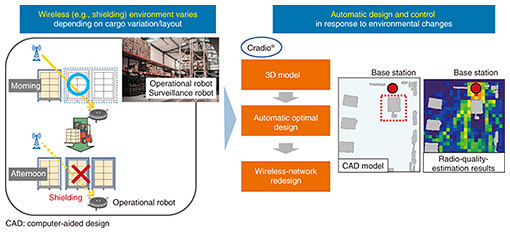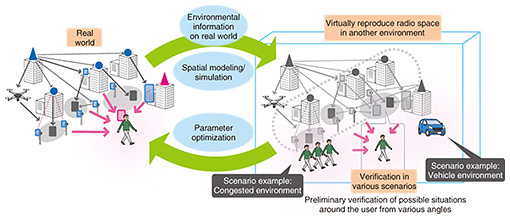 |
|||||||||||||
|
|
|||||||||||||
|
Feature Articles: Access Network Technologies for IOWN Vol. 20, No. 9, pp. 27–33, Sept. 2022. https://doi.org/10.53829/ntr202209fa3 Wireless Technologies for Future Network Services Tailored to the Requirements of Various Users and ApplicationsAbstractFor the IOWN (Innovative Optical and Wireless Network)/6G (6th-generation mobile communication system) era, wireless systems and use cases, applications, and terminals will evolve, and users and service requirements will diversify. Therefore, drastic innovation is needed, especially for wireless access, which is sensitive to the environment. This article introduces technologies for expanding the potential of wireless-access performance, control technologies that make the most of the expanded potential, and wireless-environment-verification technologies that support the development of various services. Keywords: wireless, Extreme NaaS, Cradio® 1. IntroductionWireless communication began with its use as a communication infrastructure that connects distant points. With the practical application of satellite communication, it then played a role in delivering communication to all locations. Car phones, mobile phones, and PHS (personal handy-phone system) have become more common as access methods that enable voice communication anytime. From around 2000, when data communication and wireless local area networks (LANs) using mobile phones became common, Internet connection by wireless access became widespread, speeding up and diversifying devices such as mobile terminals/smartphones, notebook personal computers, and intelligent machines. The use cases have greatly expanded due to this synergistic effect. As shown in Fig. 1, wireless access is now a means for everyone to access the Internet and is an indispensable means of communication in people’s lives.
Wireless access has been developed mainly through cellular systems that address public wireless access and wireless LANs that address private wireless access. A local (private) fifth-generation mobile communication system (5G), which provides wireless access in a local area with a cellular system, has also appeared, and wireless access is diversifying. For the 6G era, new technologies should open up various use cases by using public and private wireless access systems to create new value that exceeds that of connecting to the mobile Internet. The total amount of wireless-access traffic is predicted to triple in 2026 compared with that in 2021 [1]. There will also be a significant change in the content of the traffic. From around 2020, various organizations began to work on technological development related to 6G cellular and next-generation wireless LANs (Wi-Fi 6E, Wi-Fi 7). These technologies enable building a new wireless environment that can withstand such an increase in traffic. The Innovative Optical and Wireless Network (IOWN) Global Forum members announced IOWN in May 2019, and innovations are about to begin in the network. IOWN will make it possible to connect all people and things to the network and link everything happening in the world, such as human experiences and various physical phenomena, and wireless access will be responsible for creating new value. At NTT laboratories, network services that maintain end-to-end and extreme service requirements, including wireless access, are called Extreme Network as a Service (Extreme NaaS). We are researching and developing Extreme NaaS, as shown in Fig. 2.
To further develop wireless access, technologies that expand the potential of wireless access and those that draw out the expanded potential are required. Increasing the potential of wireless access requires two approaches: expanding the available frequencies and improving frequency-utilization efficiency. To fully draw out the expanded potential, technology to follow the changes in the wireless environment and meet the required wireless quality is necessary. NTT Access Network Service Systems Laboratories conducts research and development on increasing this potential by using two approaches. One involves developing frequencies by sharing frequencies with different systems [2, 3], and the other involves creating new high-frequency bands that had not been used to expand the available frequency resources. To improve frequency-utilization efficiency, we are focusing on developing spatial areas that use new wireless devices. To follow the changes in the wireless environment, we are researching and developing Cradio®—a set of multi-radio proactive control technologies that consists of three advanced and coordinated technology groups: wireless sensing/visualization, wireless-network-quality prediction/estimation, and wireless-network dynamic design/control. Toward the development of such new wireless access, we are actively contributing to the development of core technologies, standardization of new wireless systems, and establishment of laws and regulations that enable the effective use of new frequencies. We are promoting research and development in collaboration with various partner companies, universities, research institutes, and NTT Group operating companies, to create new value. This article introduces advanced wireless access technologies to expand the potential of wireless access. It also introduces tracking technology for changes in the wireless environment and radio-space-reproduction technology that supports various wireless-access verifications to expand network services that meet the extreme requirements of the wireless domain. 2. Advanced wireless access technologies to expand the potential of wireless accessTechnology areas that expand the potential of wireless access include those for increasing capacity, developing into unexplored regions, and integrating non-communication areas. Potential expansion plays a central role. Frequency bandwidth × frequency-utilization efficiency expresses the capacity of wireless access. The following explains efforts to expand the available frequency bandwidth. In the low-frequency band where many systems already exist, an overlay approach is suitable in which different wireless systems share frequencies. The high-frequency range of 100 GHz or higher is suitable for developing new use cases. For frequencies below the 1-GHz band, IEEE (Institute of Electrical and Electronics Engineers) 802.11ah (11ah), a new wireless LAN for Internet-of-Things (IoT), will be available in Japan [2]. The 11ah enables a wireless LAN at a frequency of 1 GHz or less with low radio-wave attenuation and low penetration loss, which drastically decreases the coverage holes and transmits high value-added information such as video transmission over a wide range. To develop wireless LANs for IoT, more stable operation will be achieved by considering new factors such as battery operation and optimizing in accordance with the 920-MHz-band radio-wave law that stipulates many rules for operation. We are making efforts to make this possible, as shown in Fig. 3.
We are also working on developing a frequency band that exceeds 100 GHz. For the 6G era, the use of frequencies above 100 GHz, which makes it possible to secure a vast bandwidth, is promising. As shown in Fig. 4, we were the first to start modeling propagation characteristics up to 300 GHz in an outdoor urban environment and contribute to the development of frequency bands by contributing to the Beyond 5G Promotion Consortium and the international standardization organization ITU-R (International Telecommunication Union - Radiocommunication Sector).
It is time for significant changes in the radio systems throughout all frequency bands. The potential of future wireless access will significantly grow by combining the frequency expansion with frequency-utilization technologies that focus on the spatial axis, such as distributed multiple-input multiple-output technology. 3. Tracking technology for changes in the wireless environmentThe wireless environment will be highly complex as various wireless systems have been implemented. The wireless terminals and use cases will become more diverse and multi-layered. The selection, design, and control of optimal wireless access according to user requirements and location is complicated. Considering the changes in the environment and conditions over time, it is challenging to fully use the potential of multiple wireless-access-system environments. NTT laboratories are researching and developing Cradio® to solve this complicated problem and achieve a broader range of optimization by linking with various industries and applications other than wireless [4, 5]. Cradio® is shown in Fig. 5, which, as mentioned above, consists of wireless sensing/visualization technology, wireless-network-quality prediction/estimation technology, and wireless-network-dynamic design/control technology. The wireless network follows changes in the environment and demands by repeating understanding, prediction, and control. We aim to continue to meet the requirements of users and services.
Figure 6 shows an example of achieving the optimization of wireless access in conjunction with the database information of a distribution warehouse. Cradio® can optimally design and control the wireless system for the warehouse environment by obtaining the information on the planned change of the environment in the warehouse from the database. It takes the data for multiple functions for radio-environment control, e.g., three-dimensional (3D) modeling, automatic optimal design, wireless-network redesign, and management. Therefore, if IOWN makes it possible to link in real time with information and functions possessed by various industries, Cradio® will harmonize the entire wireless network including applications. We believe this will lead to the creation of new value.
4. Radio-space-reproduction technologyThrough the sophistication mentioned above, we aim to expand the potential of wireless access, maximize the expanded potential, and ultimately form an intelligent wireless space around the wireless terminal in advance of the required wireless environment. It is an entirely new approach to creating an actual wireless environment, not optimizing for a given environment [6]. The critical technology supporting this approach is the radio-space-reproduction technology shown in Fig. 7. This technology reproduces radio space in another space using the wireless-environment information acquired from real space and highly accurate modeling/simulation technology. By accurately producing the modeled wireless environment, we aim to improve the spatial-reproduction accuracy for providing wireless space tailored to users and services.
5. ConclusionAs an initiative to create new value that exceeds that of connecting to the Internet using mobile phones, which has brought about the explosive spread of wireless access, we introduced wireless technologies to develop a network that matches users and services. Wireless access will evolve in various ways, e.g., integrating non-communication areas such as wireless sensing and the expansion of coverage areas to unexplored regions, both of which were omitted in this article due to space limitation. NTT Access Network Service Systems Laboratories will contribute to the innovation of wireless access for the IOWN/6G era. References
|
|||||||||||||








